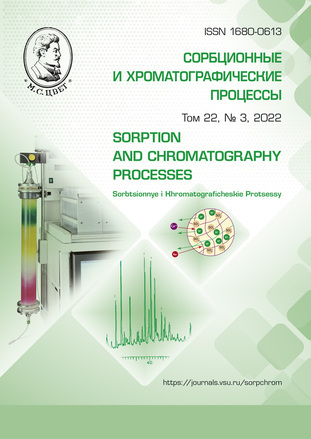Study of adsorption of histidine enantiomers on carbon nanotubes in aqueous solution based on different adsorption models
Abstract
This study is devoted to the adsorption of histidine enantiomers by carbon nanotubes from aqueous solution at 25°C. The Langmuir, BET, and cluster adsorption models were used to describe the isotherms. Histidine enantiomers by Sigma Aldrich were used as amino acids, and the mkNANO MKN-SWCNT S1 carbon nanotubes (Canada) were used as adsorbents. The isotherms were built using the method of variable concentrations. We also used ultrasonic dispersion, centrifugation, and spectrophotometry. The isotherms have two plateaus and are of type IV according to the IUPAC classification. The Langmuir model in the region of the first plateau (0≤Ce≤0.018 mol/dm3) and the BET model in the whole concentration region 0≤Ce≤
0.04 mol/dm3) only approximately agree with the experimental isotherm. The cluster model of adsorption showed a very good agreement between the theory and the experiment (R2=0.996 and R2=0.999). Using the cluster adsorption model, we demonstrated that L- and D-histidine were adsorbed on the nanotube surface in the form of monomers and clusters of size 13 (L-histidine) and 9 (D-histidine).
Downloads
References
Rakov E.G. Carbon nanotubes in new materials. Russ. Chem. Rev. 2013; 82(1): 27-47. https://doi.org/10.1070/RC2013v082n01ABEH004227
Dai H., Hafner J.H., Rinzler A.G. et al. Nanotubes as nanoprobes in scanning probe microscopy. Nature. 1996; 384: 147-150. https://doi.org/10.1038/384147a0
Zhai P., Isaacs J.A., Eckelman M.J. Net energy benefits of carbon nanotube applications. Appl. Energy. 2016; 173: 624-634. https://doi.org/10.1016/j.apenergy.2016.04.001
Zhuang L., Chen K., Corrine D. et al. Drug Delivery with Carbon Nanotubes for In vivo Cancer Treatment. Cancer. Res. 2008; 68: 6652-6660. https://doi.org/10.1158/0008-5472.CAN-08-1468
Karimi M., Solati N., Ghasemi A. et al. Carbon nanotubes part II: a remarkable carrier for drug and gene delivery. Expert Opinion on Drug Delivery. 2015; 12(7): 1089-1105. https://doi.org/10.1517/17425247.2015.1004309
Hossen S., Hossain M.K., Basher M.K. et al. Smart nanocarrier-based drug delivery systems for cancer therapy and toxicity studies: A review. Journal of Advanced Research. 2019; 15: 1-18. https://doi.org/10.1016/j.jare.2018.06.005.
Foo K.Y., Hameed B.H., Insights into the modeling of adsorption isotherm systems. Chemical Engineering Journal. 2010; 156(1): 2-10. https://doi.org/10.1016/j.cej.2009.09.013
Ebadi A., Soltan Mohammadzadeh J.S., Khudiev A. What is the correct form of BET isotherm for modeling liquid phase adsorption? Adsorption. 2009; 15(1): 65-73. https://doi.org/10.1007/s10450-009-9151-3
Butyrskaya E.V., Zapryagaev S.A., Izmailova E.A. Cooperative model of the histidine and alanine adsorption on single-walled carbon nanotubes. Carbon. 2019; 143: 276-287. https://doi.org/10.1016/j.carbon.2018.10.086
Le D.T., Butyrskaya E.V., Eliseeva T.V. Sorption Interaction between Carbon Nanotubes and Histidine Enantiomers in Aqueous Solutions. Russ. J. Phys. Chem. 2021; 95(11): 2280-2286. https://doi.org/10.31857/S004445372111011X.
Dalgliesh C. The synthesis of N′-formyl-DL-kynurenine, Nα-acetyl-DL-kynurenine and related compounds, and observations on the synthesis of kynurenine. J. Chem. Soc. 1952; 29: 137-141. https://doi.org/10.1039/jr9520000137.
Badamshina E.R., Gafurova M.P., Estrin Y.I. Modification of carbon nanotubes and synthesis of polymeric composites involving the nanotubes. Russ. Chem. Rev. 2010; 79(11): 1027-1064. https://doi.org/10.1070/RC2010v079n11ABEH004114
Seongjun P., Deepak S., Kyeongjae C. Generalized Chemical Reactivity of Curved Surfaces: Carbon Nanotubes. Nano Letters. 2003; 3(9): 1273-1277. https://doi.org/10.1021/nl0342747
Gulseren O., Yildirim T., Ciraci S. Tunable Adsorption on Carbon Nanotubes. Phys. Rev. Letters. 2001; 87(11): 1-4. https://doi.org/10.1103/PhysRevLett.87.116802
Schaefer D.W., Justice R.S. How Nano Are Nanocomposites? Macromolecules. 2007; 40(24): 8501-8517. https://doi.org/10.1021/ma070356w
Rakov E.G., Materials made of carbon nanotubes. The carbon nanotube forest. Russ. Chem. Rev. 2013; 82(6): 538-566. https://doi.org/10.1070/RC2013v082n06ABEH004340
Berthod A. Chiral Recognition Mechanisms. Anal. Chem. 2006; 78(7): 2093-2099. https://doi.org/10.1021/ac0693823
Butyrskaya E.V., Zapryagaev S.A., Izmailova E.A., Selemenev V.F. Mechanism of Sorption Interaction between L-Alanine and Carbon Nanotubes. Russ. J. Phys. Chem. 2019; 93(4): 710-716. https://doi.org/10.1134/S0036024419040071
Butyrskaya E.V., Izmailova E.A., Le D.T. Understanding structure of alanine enantiomers on carbon nanotubes in aqueous solutions. Journal of Molecular Structure. 2022; 1259(132616): 1-9. https://doi.org/10.1016/j.molstruc.2022.132616
Butyrskaya Е.V., Zapryagaev S.А., Cluster model of the step-shaped adsorption isotherm in metal-organic frameworks. Microporous and Mesoporous Materials. 2021; 322(111146): 1-10. https://doi.org/10.1016/j.micromeso.2021.111146







